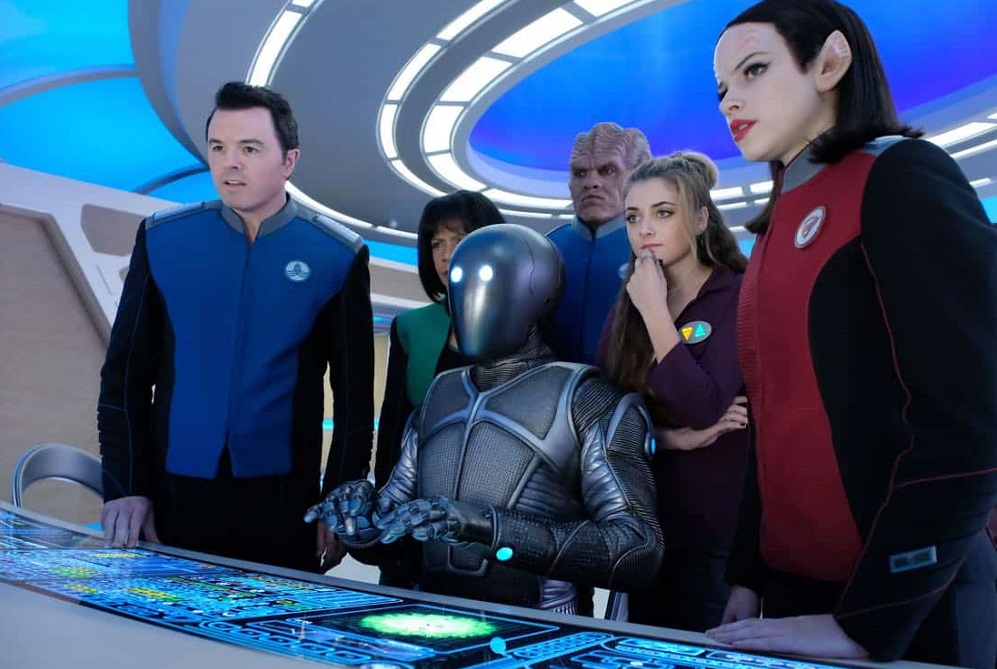
I finally saw the latest Orville episode, Majority Rule. The Orville is absolutely a great series. It reminds me so much of Star Trek: The Next Generation. As every geek probably knows by now, it parodies and emulates Star Trek to great success, even better than Star Trek itself. Many of us are probably waiting for Eaglemoss to roll out Orville miniatures. Anyway, the latest episode was both an homage to how sometimes Star Trek manages its budget and our current opinionated social media status.
Can’t do this little piece without spoiling much of the episode or at least its synopsis. So SPOILER ALERT for Orville fans. Now read on.
You know in Star Trek: The Original Series, most of its episodes take us to worlds where its residents look all too human. They’re either colonists, human-like aliens or metaphysical beings. The TOS budget on costumes and makeup is notoriously low. Heck, even the Klingons look all too human which is a stark contrast to the Klingons on Star Trek: Discovery. But now, with TV budgets rivalling B movies and Indie films, Star Trek episodes and films are filled with loads of alien races that now look very alien. The point here is, episode 7 of The Orville is a budget filler that does away with much of the costumes, makeup and effects for alien races, ships, and backdrops; but it’s a very good one. Much like the TOS episode Miri, A Piece of the Action and The City on the Edge of Forever, the latter which I really love. This episode takes the crew to Sargas 4, that has a civilization, not unlike current 21st Century Earth complete with cars, TV, coffee shops, similar clothing, and smartphones.
The main difference between Earth and Sargas 4 is its system of absolute democracy where everybody’s opinion counts. Everyone’s opinion is logged and recorded using smartphones and personal badges with an Upvote (Like) and a Downvote (Dislike) button. It’s literally Social Media in space but with a Dislike button. Here, we voice our approval of something with a Like button in Facebook, the Heart button in Twitter and the Save button in Pinterest. We don’t have a dislike button, but if we totally dislike something on Facebook, we share it and voice our disapproval (because there’s no dislike button). That dissatisfaction grows viral, and that’s what happened to navigator Lt. John Lamarr because of his lap dance on a respected statue while teasing Alara Kitan. Much like today’s society, such a thing catches the attention of mobile phone owners who record it and upload it. The same thing happened to the two exo-anthropologists whose disappearance the crew was sent to investigate. They didn’t allow a pregnant woman to be seated on a bus while they were absorbed in their work. A great thing about the Orville that aligns it with Star Trek is how it tackles current issues. This episode does so in a great way.
Allow me to digress a bit as what happened to the scientists remind me of a viral issue that happened about a year ago. There’s a fine line nowadays between chivalry, equality, and practicality. A lady rode in the men’s section of a train but was forced to stand. Everyone seated in front of her was probably either old or a woman except for a guy whom she focused on and was greatly expecting to offer her a seat. The guy was asleep or in her mind was pretending to be. So she popped a photo of him and uploaded it on Facebook where she complained the guy wasn’t a gentleman. Thankfully common sense prevailed because the guy looked absolutely exhausted (probably from a night shift) and the girl was admonished for being entitled. We are required by law to give our seats to the old, the pregnant and disabled and the girl, judging from her profile feature and latest photos wasn’t any of them. In terms of practicality, if men are on the train for most of its entire route or, carrying plenty of stuff they tend to keep their seats. Rarely do such men offer their seat to a woman clearly able to handle standing up.
Now back to our recap. The scientists failed to lend their seat to the pregnant woman resulting in a huge drop in their personal approval ratings thanks to uploads, dislikes and popular opinion through social media and network TV. One got killed trying to escape, and the other was ‘corrected’ or lobotomized. The same fate awaits LaMarr if public opinion isn’t swayed.
The Orville as a copy of Star Trek also has its own Prime Directive and covert anthropological studies. The crew is forced to work with the planet’s system of opinion-based absolute democracy. A system I used to actually dream of and I bet many do as well, where you get to decide an issue with a green or red button. Today’s social media society allows for such judgement with Like and Share buttons no matter how ill-informed either side people are on an issue. Then there are the trolls who would like nothing more than to see the world burn or a man fry. A system which condemns a man to mental impediment or even death because of ten million downvotes is terribly flawed. This Orville episode emphasizes why our current justice system, flawed it may be, is better than mob rule. Imagine a mob running Harrison Ford to the waterfall because he didn’t give an old lady a seat on the bus.
Suffice to say, the team makes it out in one piece but in spectacular fashion without any phaser fire. Again, Majority Rule is a very good episode. Very Star Trek. See it if you haven’t yet done so. Check out The Orville if you haven’t done so. Make it so.

